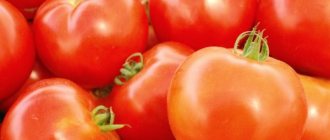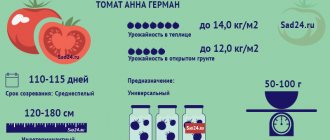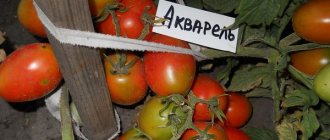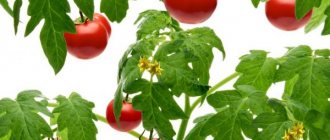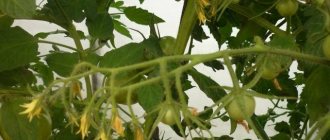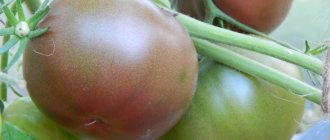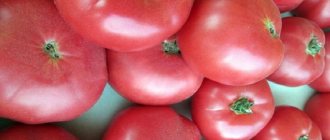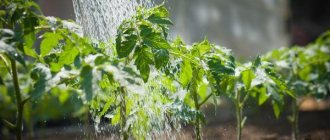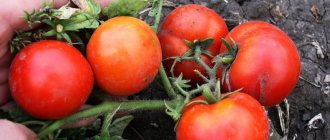Tomato Tomatoes with large pink sweet fruits are welcome residents in any summer cottage, especially if they are productive and not afraid of diseases, our hybrid of such tomatoes. It produces selected fruits suitable for salads and canning.
| Height | Landing location | Ripening time | Fruit color | Fruit size | Origin | Fruit shape |
| Medium height | Open ground | Early ripening | Pink | Large | Hybrid | Round |
Characteristics of the variety
Tarpan F1 belongs to the early ripening tomato hybrids. The period from seed germination to the first harvest is approximately 97-104 days. This is a determinate variety. Compact bushes are formed by moderate green mass. The light green leaves are medium in size. Tomato Tarpan F1 is suitable for planting in open ground and greenhouses. With proper care, you can collect 5-6 kg of fruit from one bush. When grown in greenhouses, larger tomatoes ripen.
Tarpan F1 fruits have round shapes, average size and weight 68-185 g. Usually 4 to 6 pieces are tied in one cluster.
Ripe tomatoes are usually dark pink in color (as in the photo).
Since the skin is quite dense (but not hard), ripe tomatoes do not crack. The juicy pulp of Tarpan F1 tomatoes has a sugary and dense structure, with a large number of seed chambers and is distinguished by a rich, sweetish taste.
Tarpan F1 tomatoes are served both fresh and canned.
Advantages of Tarpan F1 tomatoes:
- delicious taste of ripe juicy tomatoes;
- high productivity;
- An excellent option for baby food (as a puree). Tarpan F1 tomatoes also produce juice with a pleasant sweetish taste;
- significant savings in land area due to the compact shape of the bushes;
- excellent preservation of ripe tomatoes Tarpan F1;
- tolerate transportation well;
- green tomatoes ripen remarkably well at room temperature;
- resistant to major tomato diseases.
No critical deficiencies were identified. The natural thickening of the Tarpan F1 variety cannot be considered a flaw of the variety, since the yield level is not greatly reduced.
Advantages of Tarpan
Among the most characteristic positive differences of the variety, the following can be noted:
- attractive appearance of the fruit and excellent taste of ripened tomatoes;
- high yield;
- the ability to resist many common tomato diseases;
- small bushes can be compactly marked in a greenhouse or on a small area of a personal plot.
Reviews about this variety from those who planted it were only positive; no negative aspects were found.
Landing nuances
Manufacturers specially treat Tarpan F1 seeds. Therefore, gardeners do not need to additionally prepare seeds.
Traditional way
Since Tarpan is an early-ripening variety, it is recommended to sow seeds for seedlings in early March.
- The soil for planting is prepared: garden soil is mixed with humus and turf. If you haven’t stocked up on soil in advance, then ready-made soil for seedlings can be purchased in special stores.
- Shallow grooves are made on the soil surface. Tarpan F1 tomato seeds are sown and loosely dug in.
- The box is sprayed with water and covered with plastic wrap.
As soon as the first shoots of tomatoes appear, it is advisable to move the container to a well-lit place. At this stage, it is important not to get carried away with watering - the soil should remain loose.
Advice! To water young seedlings of Tarpan F1 tomatoes, it is recommended to use a watering can (with small and frequent holes) or even a spray bottle.
When the first two leaves are formed, you can plant the Tarpan F1 tomato seedlings in separate cups. At this stage, it is advisable to feed the plants with complex mineral fertilizer. A seedling with a strong stem and several leaves (from 6 to 8) is suitable for planting in open ground.
As soon as the soil warms up confidently, you can start planting tomato seedlings in open ground (most often this is the first days of May). The optimal number of seedlings is 4-5 pieces per square meter. It is advisable to form single-row or double-row plantings of Tarpan F1 tomatoes (40x40 cm). To improve air exchange, it is recommended to remove the lower leaves. You can pinch the side shoots after the fourth brush.
Using agrofibre
To speed up the harvest, they use the technology of growing tomatoes using agrofibre. This method allows you to plant Tarpan F1 seedlings in open ground 20-35 days earlier (the period will vary in different regions).
- The entire area is covered with black agrofibre (density of at least 60 microns). Particular attention is paid to the composition of the soil. If it is heavy clay soil, then it is worth additionally mulching the soil - adding sawdust and hay. This measure will prevent the soil from drying out and cracks forming.
- The canvas is fixed along the perimeter - you can dig it in or put some kind of weight (stones, beams).
- Rows are being planned for planting Tarpan F1 tomato seedlings. 70-85 cm are laid on the row spacing. To plant Tarpan seedlings in a row, cross-shaped cuts are made in the canvas. A distance of 25-30 cm is maintained between bushes. 5
- Holes are dug in the holes of the agrofibre and tomatoes are planted. It is recommended to immediately install a support for seedlings of the Tarpan F1 variety - this will help the sprouts to quickly strengthen and withstand strong gusts of wind.
The seedlings are watered, and after one and a half to two weeks the first feeding can be done.
Main stages of cultivation
Tarpan is a mid-early tomato; the period from germination to the first harvest is 100–105 days. The sequence of cultivation procedures includes:
- seed germination;
- sowing them for seedlings;
- growing seedlings;
- rooting in the ground;
- plant care;
- harvesting.
The timing of the activities is calculated based on the main time intervals of the growing season. Moreover, the countdown is carried out from the date of rooting of seedlings in the ground.
If it is intended to use temporary shelters made of frames and film or spunbond, then this is done two weeks earlier, in mid-May.
Seedlings are planted in greenhouses a month earlier, in early May. The age of seedlings from germination to planting is 55-60 days.
Here are the main dates for growing tomatoes in a greenhouse:
- February 25 - laying seeds for germination;
- March 1—sowing;
- March 5 - shoots;
- May 5 - planting seedlings in the ground;
- June 20 - first harvest.
Germination of seeds
Hybrids, unlike varieties, are grown from seeds of manufacturing companies. Such seeds have already undergone all the necessary pre-sowing preparation and, among other things, do not require dressing.
The germination procedure is not only a test for germination, but will allow you to select the strongest and most viable plants in the future.
A piece of cotton cloth folded in several layers and soaked in water is placed in a container with an airtight lid. The seeds are laid out on it, it is closed with a lid and placed in a warm place (26-28 degrees).
Attention! Seeds should not be in water!
Germination ends when the sizes of white sprouts and seeds are equal.
For sowing seedlings, you can use any purchased soil. Your substrate, prepared in the fall, must first be disinfected. To do this, you can use a weak solution of potassium permanganate, which is used to spill the soil. This is done in advance so that the soil has time to dry before use.
The last operation is filling with a full mineral complex NPK (nitrogen, phosphorus, potassium). This is done in the proportion of 1 tablespoon of fat per bucket of earth. To avoid picking that is traumatic to young shoots, seeds must be sown immediately in separate containers (cups or cassettes). The soil in them should be moist, sowing depth 1 cm.
Seedling care
It is necessary to water the seedlings when the top layer of soil dries. Otherwise, this may provoke the development of fungal diseases (mold).
The second mandatory procedure is not burdensome. To avoid curvature of the shoots, they must be regularly turned away from the light.
It is recommended to do two such procedures with tomato seedlings within 2 months. And they do the same when planting in the ground.
The time when this can be done is determined by two factors:
- The threat of return frosts should pass.
- The soil temperature at a depth of 20 cm (spade bayonet) will reach 12 °C.
The compactness of Tarpan bushes allows you to choose a planting density of 5 plants per square meter. meter, which leads to a layout of 50x40 cm. On large plantations, for ease of access to plants, preference should be given to an arrangement of 70x40 cm.
In principle, this determinant does not need a garter, but it will not be superfluous either. Therefore, you must immediately drive a support peg into the planting hole. And a teaspoon of the full composition of fat is poured there and mixed with the soil.
READ MORE: Sweet bunch tomato characteristics and description of the variety, yield with photos
If the seedlings are overgrown, they can be planted obliquely (lying down).
Plant care
It is no different from the generally accepted one. Regularly you need to do weeding, watering, loosening the soil to aerate the root system. Removing the lower leaves and tying will improve ventilation conditions, which will be a good prevention of fungal diseases, especially in greenhouses. At the stage of fruit set, the last feeding is carried out. In this case, nitrogen must be excluded from the complex.
Watering tomatoes
This vegetable is not a moisture-loving plant. However, it will not be possible to get a bountiful harvest with random watering. It is recommended to water Tarpan tomatoes when the top layer of soil dries out.
Important! During dry periods, it is better to water Tarpan tomatoes once a week, but generously. Moreover, it is necessary to avoid getting moisture on the stems and leaves of the plant.
When Tarpan tomatoes are flowering, watering is carried out weekly (about five liters of water are poured under each bush), but stagnation of liquid is not allowed.
During the ripening of tomatoes, it is advisable to increase watering to twice every 7-10 days. It is important to take into account the air temperature. In cool summers, it is recommended to pour 2-3 liters of water under the bush.
The optimal way to water plants is drip irrigation. Advantages of the technology: water enters directly into the root system, economical use of water is achieved, and there will be no sudden changes in soil moisture on mulched soil.
When choosing an irrigation system, you need to take into account the climatic features of the region.
Planting seedlings
The time for planting seedlings in open ground is primarily affected by weather conditions. The possibility of recurrence of frost and the soil temperature in the region should be taken into account.
Although the size of the bushes is small, it is not recommended to thicken the planting of tomatoes. Water the tomatoes with water heated under the sun. Avoid excessive watering. It is better to do this more often, but in moderation. After watering, the next day, the soil around the bushes is loosened. This ensures that the roots retain moisture for a longer time. To increase productivity, tomatoes are fed three times a season.
Plant nutrition
Tomatoes are considered a crop that responds gratefully to fertilizers. The choice of fertilizing is determined by the quality of the soil and weather conditions. It is important to understand that a lack of nutrition will lead to improper development of the Tarpan tomato variety, and an excess will provoke weak formation of ovaries.
During the formation of green mass, it is important to provide the plant with nitrogen (urea, nitrate). Especially if the seedlings are thin and weak. A mineral mixture is prepared per square meter of area: 10 g of saltpeter, 5 g of urea (or 10 g of nitrophoska), 20 g of superphosphate and potassium salt.
After the formation of the second flower brush, ready-made mineral mixtures are used. A good fertilizer option is “Signor Tomato” (the composition includes nitrogen, potassium, phosphorus in a ratio of 1: 4: 2). For root feeding of tomato variety Tarpan F1, use a solution (five tablespoons per eight liters of water), infused for more than three hours. For one plant, a liter of solution every one and a half to two weeks is enough.
Description of fruits
Almost the entire harvest has marketable fruit. Their distinctive feature is the following parameters:
- tomatoes have a red-pink hue;
- the shape resembles a sphere flattened at the bottom and top;
- ribbing is weakly expressed;
- relatively dense outer skin;
- quite juicy pulp;
- pleasant sweetish taste;
- the fruits are of medium size, but grown in greenhouse conditions can reach 200 grams;
- retain their qualities and do not lose their presentation during long-term storage;
- are not afraid of transportation;
- After harvesting at the stage of technical maturity, they ripen well.
Read also: Honeysuckle Delight: description of the variety, photos, reviews
In cooking, these tomatoes are used for raw consumption and for making salads. They are suitable for preparing preserves. Small size allows you to marinate whole in jars. Tarpan tomatoes are often used in baby food for preparing vegetable purees and juices.
Pests and diseases
The Tarpan hybrid is a tomato variety resistant to major diseases: fusarium, tobacco mosaic. As a preventive measure, before planting seedlings, you can treat the soil with a solution of hydrogen peroxide or copper sulfate.
To prevent the appearance of late blight, Tarpan tomatoes are sprayed with phytosporin or some harmless biological product with an antifungal effect.
Among the pests during the flowering period of tomatoes, you should be wary of spider mites and thrips. And already when the fruits ripen, it is necessary to control the appearance of aphids, slugs, and Colorado potato beetles. Periodic weeding and mulching of the soil will help prevent the appearance of insects.
When choosing a tomato variety, many factors must be taken into account: proper watering, seedling planting scheme, the presence of a mulch layer, and the temperature characteristics of the region. Thanks to the characteristics of the Tarpan variety and taking into account climatic conditions, you can get an early harvest.
